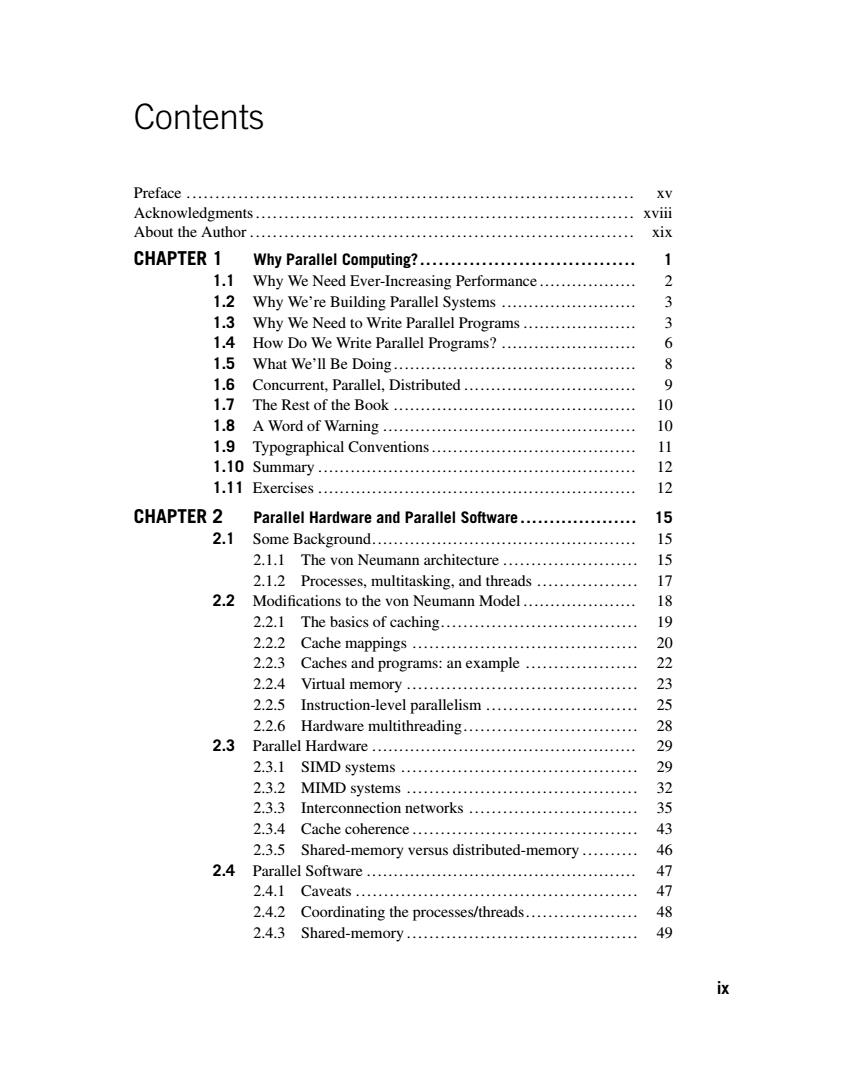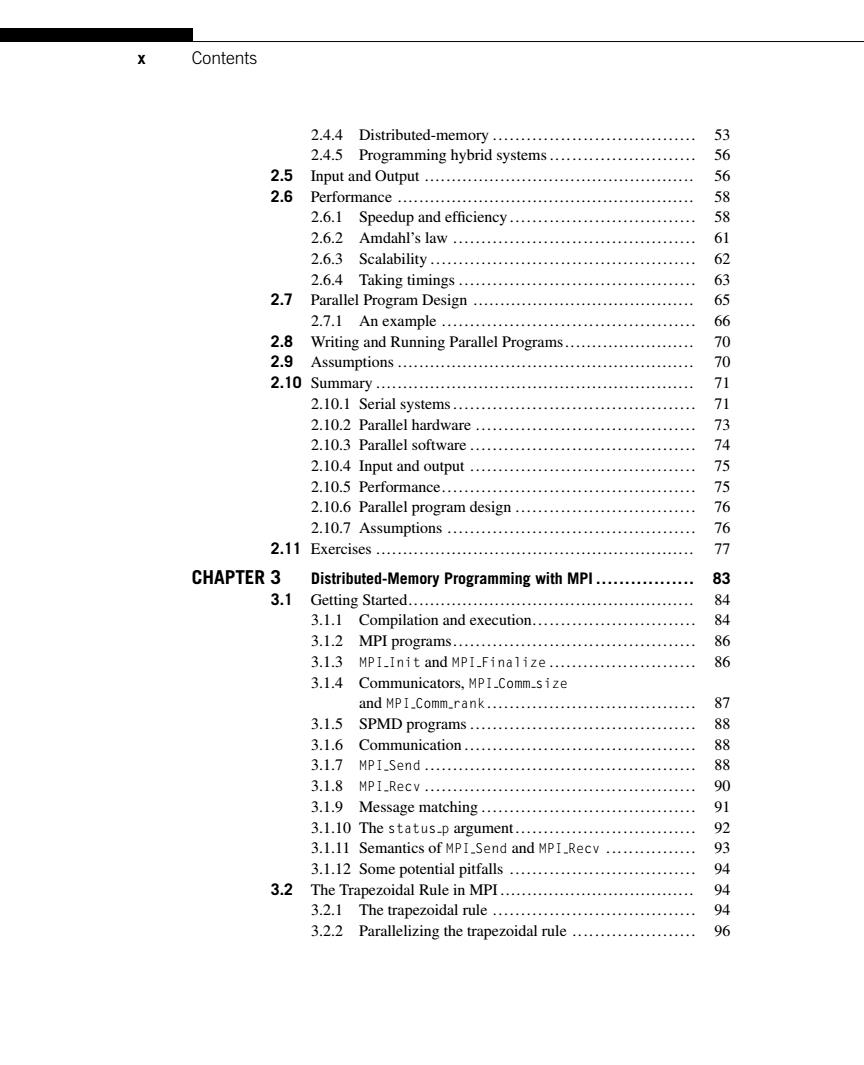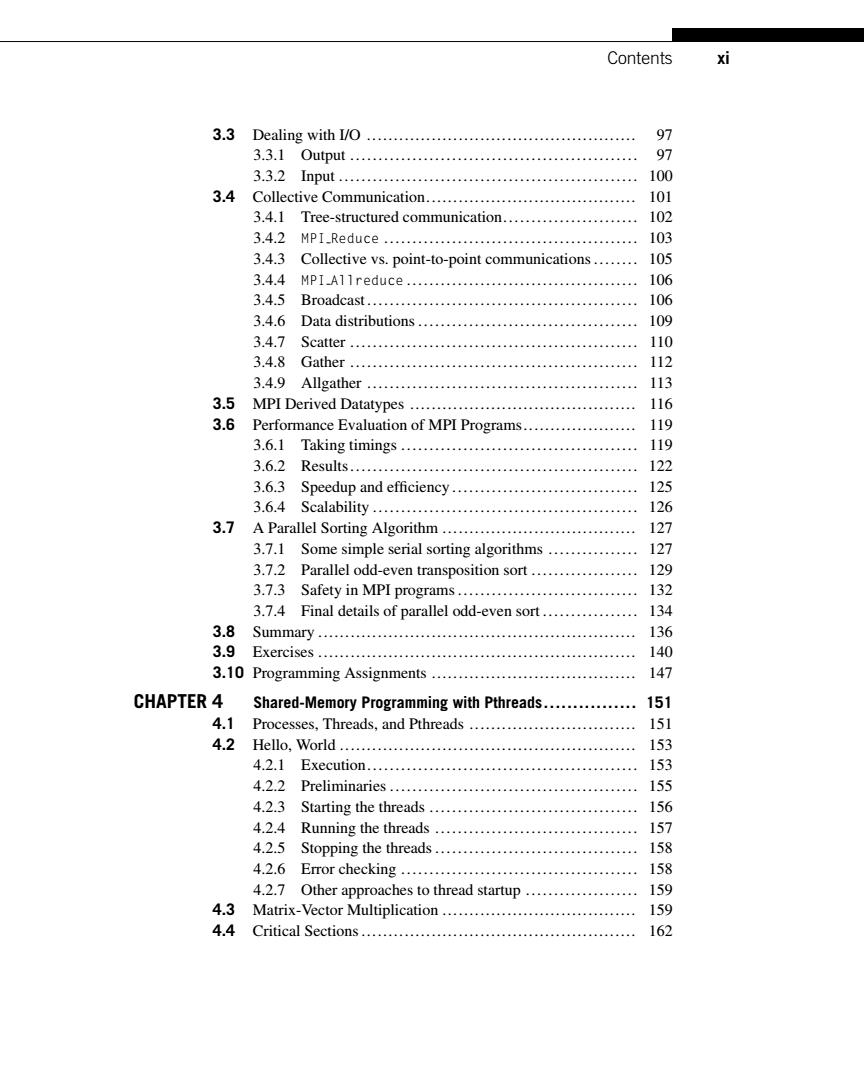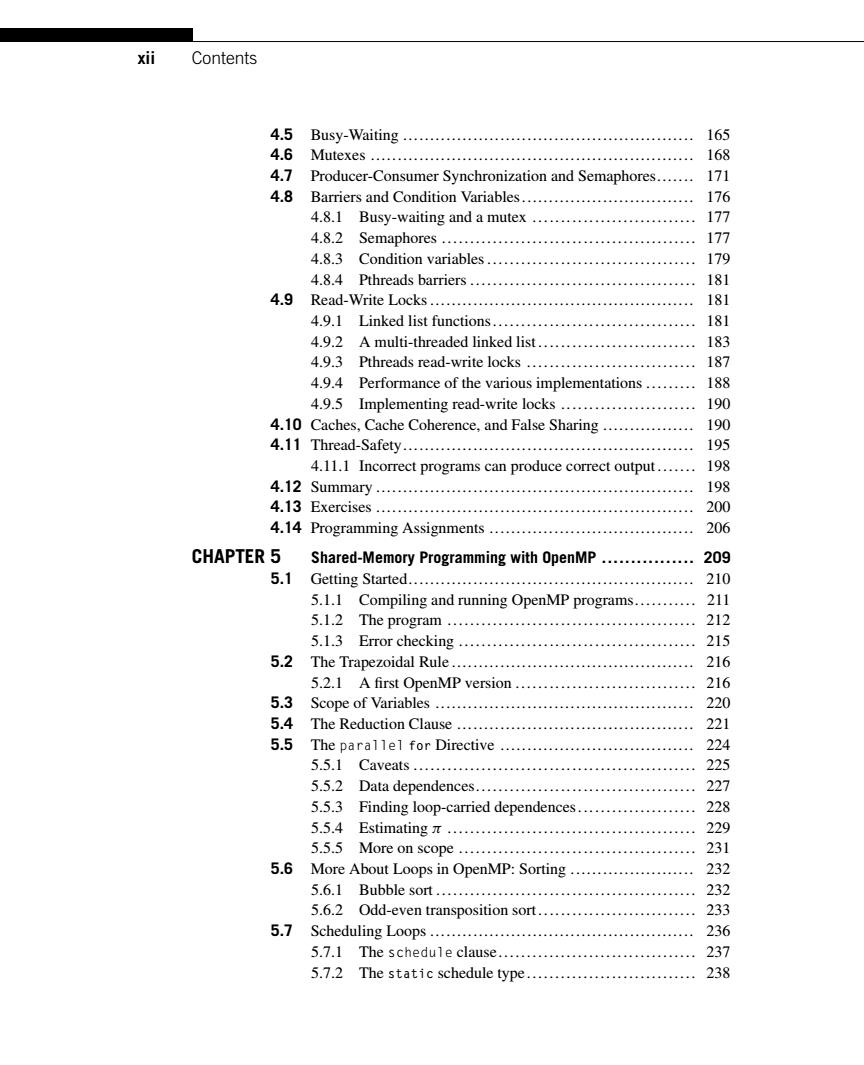
An Introduction to PARAL■LEL PR①GRAMMING Peter Pacheco M< HORSA时KAUPHA鲜N

Contents Preface ................................................................................ XV Acknowledgments.… xviii About the Author…… xix CHAPTER 1 Why Parallel Computing?................................... 1 1.1 Why We Need Ever-Increasing Performance.................. 2 1.2 Why We're Building Parallel Systems ....................... 3 1.3 Why We Need to Write Parallel Programs..................... 3 1.4 How Do We Write Parallel Programs?......................... 6 1.5 What We'll Be Doing.................................... 8 1.6 Concurrent,Parallel,Distributed............................... 9 1.7 The Rest of the Book................................. 10 1.8 A Word of Warning............................................... 10 1.9 Typographical Conventions..... 11 1.10 Summary............................................ 12 1.11 Exercises.… 12 CHAPTER 2 Parallel Hardware and Parallel Software.................... 15 2.1 Some Background.... 15 2.1.1 The von Neumann architecture........................ 15 2.1.2 Processes,multitasking,and threads.................. 17 2.2 Modifications to the von Neumann Model..................... 18 2.2.1 The basics of caching................................ 19 2.2.2 Cache mappings................ 20 2.2.3 Caches and programs:an example 22 2.2.4 Virtual memory ....................................... 23 2.2.5 Instruction-level parallelism........................... 25 2.2.6 Hardware multithreading.............................. 28 2.3 Parallel Hardware.… 29 2.3.1 SIMD systems.… 29 2.3.2 MIMD systems.........… 32 2.3.3 Interconnection networks.............................. 35 2.3.4 Cache coherence................... 43 2.3.5 Shared-memory versus distributed-memory.......... 46 2.4 Parallel Software..................................... 47 2.4.1 Caveats.......... 47 2.4.2 Coordinating the processes/threads.................... 48 2.4.3 Shared-memory.............................. 49 i送
Contents Preface .............................................................................. xv Acknowledgments .................................................................. xviii About the Author ................................................................... xix CHAPTER 1 Why Parallel Computing?................................... 1 1.1 Why We Need Ever-Increasing Performance .................. 2 1.2 Why We’re Building Parallel Systems ......................... 3 1.3 Why We Need to Write Parallel Programs ..................... 3 1.4 How Do We Write Parallel Programs? ......................... 6 1.5 What We’ll Be Doing ............................................. 8 1.6 Concurrent, Parallel, Distributed ................................ 9 1.7 The Rest of the Book ............................................. 10 1.8 A Word of Warning ............................................... 10 1.9 Typographical Conventions ...................................... 11 1.10 Summary ........................................................... 12 1.11 Exercises ........................................................... 12 CHAPTER 2 Parallel Hardware and Parallel Software .................... 15 2.1 Some Background................................................. 15 2.1.1 The von Neumann architecture ........................ 15 2.1.2 Processes, multitasking, and threads .................. 17 2.2 Modifications to the von Neumann Model ..................... 18 2.2.1 The basics of caching................................... 19 2.2.2 Cache mappings ........................................ 20 2.2.3 Caches and programs: an example .................... 22 2.2.4 Virtual memory ......................................... 23 2.2.5 Instruction-level parallelism ........................... 25 2.2.6 Hardware multithreading............................... 28 2.3 Parallel Hardware ................................................. 29 2.3.1 SIMD systems .......................................... 29 2.3.2 MIMD systems ......................................... 32 2.3.3 Interconnection networks .............................. 35 2.3.4 Cache coherence ........................................ 43 2.3.5 Shared-memory versus distributed-memory .......... 46 2.4 Parallel Software .................................................. 47 2.4.1 Caveats .................................................. 47 2.4.2 Coordinating the processes/threads.................... 48 2.4.3 Shared-memory ......................................... 49 ix

X Contents 2.4.4 Distributed-memory.................................... 53 2.4.5 Programming hybrid systems.......................... 56 2.5 Input and Output............................. 56 2.6 Performance....................... 58 2.6.1 Speedup and efficiency................................. 58 2.6.2 Amdahl's law..................................... 61 2.6.3 Scalability.............................................. 62 2.6.4 Taking timings..................................... 63 2.7 Parallel Program Design............ 65 2.7.1 An example..… 66 2.8 Writing and Running Parallel Programs........................ 70 2.9 Assumptions… 70 2.10 Summary… 71 2.10.1 Serial systems........................................... 71 2.10.2 Parallel hardware................................ 73 2.10.3 Parallel software................................ 74 2.10.4 Input and output ................................... 75 2.l0.5 Performance.… 75 2.10.6 Parallel program design ............................... 76 2.10.7 Assumptions.… 76 2.11 Exercises..... 77 CHAPTER 3 Distributed-Memory Programming with MPl................. 83 3.1 Getting Started.… 84 3.1.1 Compilation and execution.......................... 84 3.1.2 MPI programs.… 86 3.1.3 MPI_Init and MPI_Finalize.......................... 86 3.1.4 Communicators,MPI_Comm_size and MPI.Comm_rank.… 87 3.1.5 SPMD programs............................ 88 3.1.6 Communication........................................ 88 3.1.7 MPI_Send.… 88 3.1.8MP1_ReCV.… 90 3.1.9 Message matching................................... 91 3.l.10 The status-p argument.…....… 92 3.1.11 Semantics of MPI_Send and MPI_Recv................ 93 3.1.12 Some potential pitfalls ................... 94 3.2 The Trapezoidal Rule in MPI........................... 94 3.2.1 The trapezoidal rule................................... 94 3.2.2 Parallelizing the trapezoidal rule...................... 96
x Contents 2.4.4 Distributed-memory .................................... 53 2.4.5 Programming hybrid systems .......................... 56 2.5 Input and Output .................................................. 56 2.6 Performance ....................................................... 58 2.6.1 Speedup and efficiency ................................. 58 2.6.2 Amdahl’s law ........................................... 61 2.6.3 Scalability ............................................... 62 2.6.4 Taking timings .......................................... 63 2.7 Parallel Program Design ......................................... 65 2.7.1 An example ............................................. 66 2.8 Writing and Running Parallel Programs........................ 70 2.9 Assumptions ....................................................... 70 2.10 Summary ........................................................... 71 2.10.1 Serial systems ........................................... 71 2.10.2 Parallel hardware ....................................... 73 2.10.3 Parallel software ........................................ 74 2.10.4 Input and output ........................................ 75 2.10.5 Performance............................................. 75 2.10.6 Parallel program design ................................ 76 2.10.7 Assumptions ............................................ 76 2.11 Exercises ........................................................... 77 CHAPTER 3 Distributed-Memory Programming with MPI ................. 83 3.1 Getting Started..................................................... 84 3.1.1 Compilation and execution............................. 84 3.1.2 MPI programs........................................... 86 3.1.3 MPI Init and MPI Finalize .......................... 86 3.1.4 Communicators, MPI Comm size and MPI Comm rank..................................... 87 3.1.5 SPMD programs ........................................ 88 3.1.6 Communication ......................................... 88 3.1.7 MPI Send ................................................ 88 3.1.8 MPI Recv ................................................ 90 3.1.9 Message matching ...................................... 91 3.1.10 The status p argument ................................ 92 3.1.11 Semantics of MPI Send and MPI Recv ................ 93 3.1.12 Some potential pitfalls ................................. 94 3.2 The Trapezoidal Rule in MPI .................................... 94 3.2.1 The trapezoidal rule .................................... 94 3.2.2 Parallelizing the trapezoidal rule ...................... 96

Contents xi 3.3 Dealing with/0.… 97 3.3.10 utput.… 97 3.3.2nput.… 100 3.4 Collective Communication............................... 101 3.4.1 Tree-structured communication........................ 102 3.4.2 MPI_Reduce.… 103 3.4.3 Collective vs.point-to-point communications........ 105 3.4.4MPIA11 reduce.… 106 3.4.5 Broadcast......... 106 3.4.6 Data distributions...................................... 109 3.4.7 Scatter… 110 3.4.8 Gather....... 112 3.4.9 Allgather… 113 3.5 MPI Derived Datatypes................................. 116 3.6 Performance Evaluation of MPI Programs..................... 119 3.6.1 Taking timings.................................. 119 3.6.2 Results.… 122 3.6.3 Speedup and efficiency........................... 125 3.6.4 Scalability............................................... 126 3.7 A Parallel Sorting Algorithm.................................. 127 3.7.1 Some simple serial sorting algorithms ............... 127 3.7.2 Parallel odd-even transposition sort................... 129 3.7.3 Safety in MPI programs.............................. 132 3.7.4 Final details of parallel odd-even sort................. 134 3.8 Suimmary................................. 136 3.9 Exercises.… 140 3.10 Programming Assignments........................ 147 CHAPTER 4 Shared-Memory Programming with Pthreads................ 151 4.1 Processes,Threads,and Pthreads.............................. 151 4.2 Hello,World.................... 153 4.2.1 Execution.… 153 4.2.2 Preliminaries............................................ 155 4.2.3 Starting the threads.................................. 156 4.2.4 Running the threads ................................. 157 4.2.5 Stopping the threads....................... 158 4.2.6 Error checking… 158 4.2.7 Other approaches to thread startup.................... 159 4.3 Matrix-Vector Multiplication............................ 159 4.4 Critical Sections.......................................... 162
Contents xi 3.3 Dealing with I/O .................................................. 97 3.3.1 Output ................................................... 97 3.3.2 Input ..................................................... 100 3.4 Collective Communication....................................... 101 3.4.1 Tree-structured communication........................ 102 3.4.2 MPI Reduce ............................................. 103 3.4.3 Collective vs. point-to-point communications ........ 105 3.4.4 MPI Allreduce ......................................... 106 3.4.5 Broadcast ................................................ 106 3.4.6 Data distributions ....................................... 109 3.4.7 Scatter ................................................... 110 3.4.8 Gather ................................................... 112 3.4.9 Allgather ................................................ 113 3.5 MPI Derived Datatypes .......................................... 116 3.6 Performance Evaluation of MPI Programs..................... 119 3.6.1 Taking timings .......................................... 119 3.6.2 Results................................................... 122 3.6.3 Speedup and efficiency ................................. 125 3.6.4 Scalability ............................................... 126 3.7 A Parallel Sorting Algorithm .................................... 127 3.7.1 Some simple serial sorting algorithms ................ 127 3.7.2 Parallel odd-even transposition sort ................... 129 3.7.3 Safety in MPI programs ................................ 132 3.7.4 Final details of parallel odd-even sort ................. 134 3.8 Summary ........................................................... 136 3.9 Exercises ........................................................... 140 3.10 Programming Assignments ...................................... 147 CHAPTER 4 Shared-Memory Programming with Pthreads................ 151 4.1 Processes, Threads, and Pthreads ............................... 151 4.2 Hello, World ....................................................... 153 4.2.1 Execution................................................ 153 4.2.2 Preliminaries ............................................ 155 4.2.3 Starting the threads ..................................... 156 4.2.4 Running the threads .................................... 157 4.2.5 Stopping the threads .................................... 158 4.2.6 Error checking .......................................... 158 4.2.7 Other approaches to thread startup .................... 159 4.3 Matrix-Vector Multiplication .................................... 159 4.4 Critical Sections ................................................... 162

xii Contents 4.5 Busy-Waiting.… 165 4.6 Mutexes.… 168 4.7 Producer-Consumer Synchronization and Semaphores....... 171 4.8 Barriers and Condition Variables............................ 176 4.8.1 Busy-waiting and a mutex............................. 177 4.8.2 Semaphores… 177 4.8.3 Condition variables..................................... 179 4.8.4 Pthreads barriers........................................ 181 4.9 Read-Write Locks................................................. 181 4.9.1 Linked list functions.................................... 181 4.9.2 A multi-threaded linked list............................ 183 4.9.3 Pthreads read-write locks.............................. 187 4.9.4 Performance of the various implementations......... 188 4.9.5 Implementing read-write locks........................ 190 4.10 Caches,Cache Coherence,and False Sharing......... 190 4.11 Thread-Safety.… 195 4.11.1 Incorrect programs can produce correct output.......198 4.12 Summary.… 198 4.13 Exercises..… 200 4.14 Programming Assignments................................... 206 CHAPTER 5 Shared-Memory Programming with OpenMP............. 209 5.1 Getting Started............................................... 210 5.1.1 Compiling and running OpenMP programs........... 211 5.1.2 The program.…… 212 5.1.3 Error checking ........................................ 215 5.2 The Trapezoidal Rule................ 216 5.2.1 A first OpenMP version............................. 216 5.3 Scope of Variables..... 220 5.4 The Reduction Clause...................................... 221 5.5 The parallel for Directive............................... 224 5.5.1 Caveats.… 225 5.5.2 Data dependences............................. 227 5.5.3 Finding loop-carried dependences..................... 228 5.5.4 Estimatingπ.....…..… 229 5.5.5 More on scope.… 231 5.6 More About Loops in OpenMP:Sorting................... 232 5.6.1 Bubble sort...… 232 5.6.2 Odd-even transposition sort............................ 233 5.7 Scheduling Loops........... 236 5.7.1 The schedule clause................................... 237 5.7.2 The static schedule type.......................... 238
xii Contents 4.5 Busy-Waiting ...................................................... 165 4.6 Mutexes ............................................................ 168 4.7 Producer-Consumer Synchronization and Semaphores....... 171 4.8 Barriers and Condition Variables................................ 176 4.8.1 Busy-waiting and a mutex ............................. 177 4.8.2 Semaphores ............................................. 177 4.8.3 Condition variables ..................................... 179 4.8.4 Pthreads barriers ........................................ 181 4.9 Read-Write Locks ................................................. 181 4.9.1 Linked list functions.................................... 181 4.9.2 A multi-threaded linked list ............................ 183 4.9.3 Pthreads read-write locks .............................. 187 4.9.4 Performance of the various implementations ......... 188 4.9.5 Implementing read-write locks ........................ 190 4.10 Caches, Cache Coherence, and False Sharing ................. 190 4.11 Thread-Safety...................................................... 195 4.11.1 Incorrect programs can produce correct output ....... 198 4.12 Summary ........................................................... 198 4.13 Exercises ........................................................... 200 4.14 Programming Assignments ...................................... 206 CHAPTER 5 Shared-Memory Programming with OpenMP ................ 209 5.1 Getting Started..................................................... 210 5.1.1 Compiling and running OpenMP programs........... 211 5.1.2 The program ............................................ 212 5.1.3 Error checking .......................................... 215 5.2 The Trapezoidal Rule ............................................. 216 5.2.1 A first OpenMP version ................................ 216 5.3 Scope of Variables ................................................ 220 5.4 The Reduction Clause ............................................ 221 5.5 The parallel for Directive .................................... 224 5.5.1 Caveats .................................................. 225 5.5.2 Data dependences....................................... 227 5.5.3 Finding loop-carried dependences..................... 228 5.5.4 Estimating π ............................................ 229 5.5.5 More on scope .......................................... 231 5.6 More About Loops in OpenMP: Sorting ....................... 232 5.6.1 Bubble sort .............................................. 232 5.6.2 Odd-even transposition sort ............................ 233 5.7 Scheduling Loops ................................................. 236 5.7.1 The schedule clause................................... 237 5.7.2 The static schedule type.............................. 238